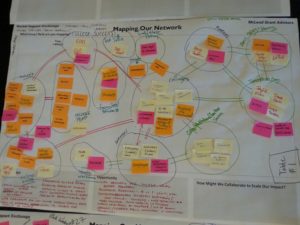
Following her opening plenary speech at the Social Impact Exchange Conference on Scaling Impact on the morning of June 18, Heather McLeod Grant facilitated a two-hour interactive session called The Whole Is Greater Than the Sum of the Parts. This session translated the conceptual ideas and learning from McLeod Grant’s speech and the subsequent panel into practical skill sets for network-mapping. The power of this technique extends beyond the practical understanding of how to map a network to a more intricate “knowledge-share process” among stakeholders.
Concepts, strategies, and ideas were put into practice by bringing different stakeholders to the table, thus creating a shared understanding of the problem at hand. Who are the stakeholders? Where are the barriers, opportunities, and missing links? Network mapping provided us attendees the opportunity to increase awareness and understanding of systems behind social issues, such as education, health, and poverty alleviation.
Even if these questions and the process of mapping were not new to all of us, this activity brought this discussion and awareness to the forefront of our minds. In addition, working together in small groups gave each of us exposure to how others visualized and understood the main stakeholders and these systems at large. While our groups did not develop shared strategies or prototype collaborative ideas, we engaged with these social challenges by coming together to map out this system and its associated network.
This mapping activity also illuminated how each group member and their network may play a part within these systems. My table, for example, was assigned the topic of college access, which we decided to frame in terms of ‘college success.’ As we organized and discussed our collaborative list of stakeholders, group members realized mutual connections and learned about new innovations, funders, and collaborators from each other.
Often, we would tell each other that we want to talk to them more about a certain person, topic, organization, or idea afterwards. Once this session ended, our group continued to talk about these newfound connections and interests and where our current work aligned. These follow up conversations highlighted how mapping out this conceptual system resulted in our engagement with each other and with each other’s respective and overlapping networks. In fact, this expansion of our individual and collective networks could even lead to potential collaborative efforts in the future.
Whether the end product looked like a hectic swirl of connecting lines or linear pathways of color-coded stakeholders, these network maps illuminated the power of shared knowledge when personal experiences and understanding are leveraged through shared networks and visions. These maps show the potential of collaborative efforts by multi-stakeholders with a shared vision, strategy, and willingness to make small bets to drive large-scale social change.
Taylor Nelson is the Development and Administrative Associate at the Solutions Journalism Network.